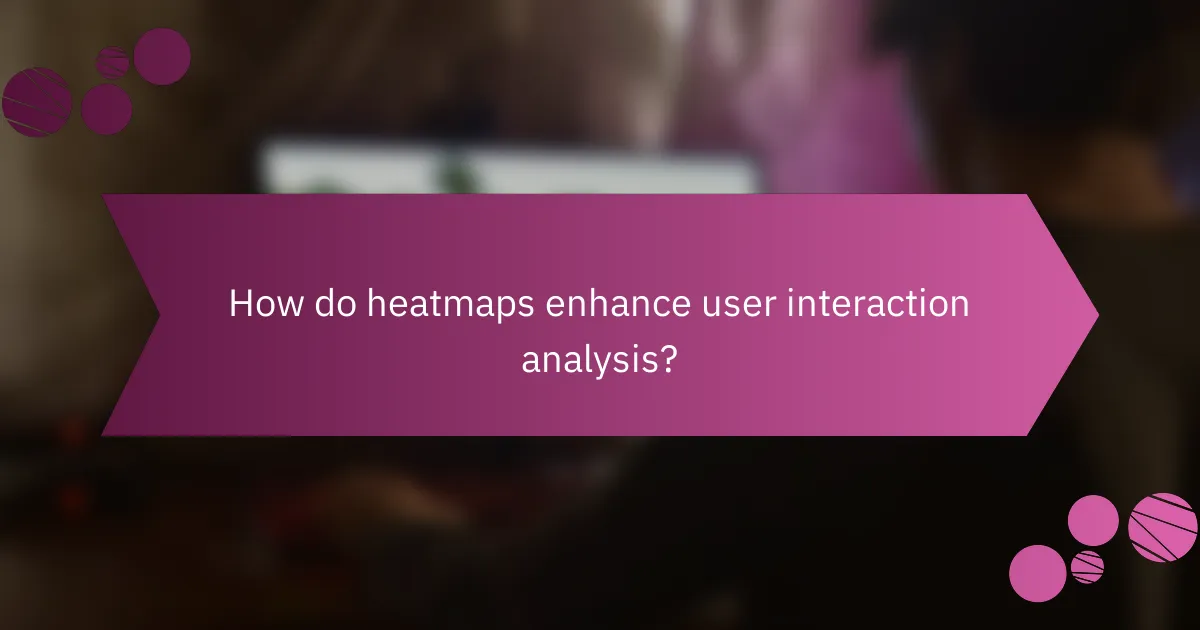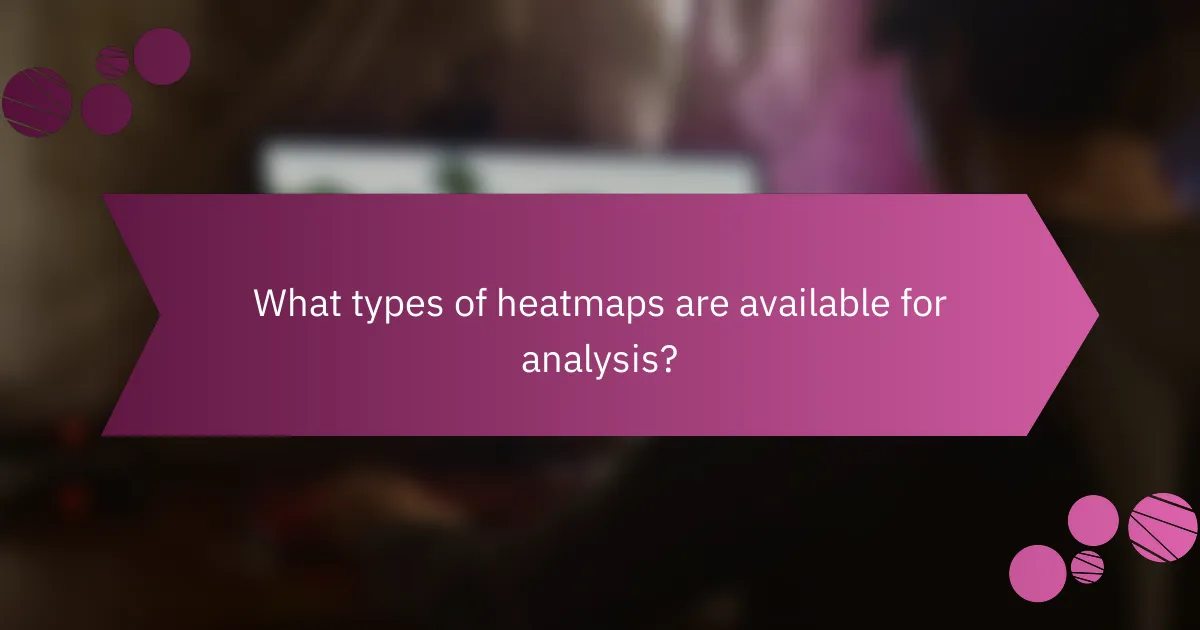Heatmaps are powerful tools for analyzing user interactions by visually depicting how users engage with websites or applications. By highlighting areas of interest and interaction patterns, they provide valuable insights that can guide design and functionality improvements. Different types of heatmaps, such as click, scroll, and mouse movement heatmaps, offer unique perspectives on user behavior, enabling businesses to optimize user experience and enhance conversion rates.

How do heatmaps enhance user interaction analysis?
Heatmaps enhance user interaction analysis by visually representing how users engage with a website or application. They provide insights into user behavior, helping identify areas of interest and interaction patterns that can inform design and functionality improvements.
Visual representation of user behavior
Heatmaps offer a graphical depiction of user interactions, using color gradients to indicate where users click, scroll, or hover. This visual format makes it easy to identify which sections of a page attract the most attention and which areas are ignored. For instance, a heatmap might show that users frequently click on a specific button while largely overlooking others.
By analyzing these visual cues, designers can make informed decisions about layout and content placement to enhance user experience. Tools like Crazy Egg or Hotjar can generate these heatmaps, providing a clear overview of user engagement.
Identification of engagement hotspots
Engagement hotspots are areas on a webpage where users show significant interaction, often indicated by warmer colors on a heatmap. Identifying these hotspots allows businesses to understand what captures user interest and drives action. For example, if a particular product image consistently receives clicks, it may warrant more prominent placement or additional marketing efforts.
Conversely, areas with little to no engagement can signal content or design issues that need addressing. Regularly reviewing heatmaps can help track changes in user behavior over time, ensuring that content remains relevant and engaging.
Insights into user navigation patterns
Heatmaps reveal user navigation patterns by showing how users move through a site. By analyzing these patterns, businesses can identify common pathways taken by users, which can inform site structure and content organization. For instance, if users frequently navigate from a blog post to a product page, it may indicate a successful content strategy that encourages purchases.
Understanding these navigation trends can also highlight potential barriers to conversion. If users drop off at a specific point, it may be necessary to simplify the navigation or provide clearer calls to action. Regularly updating heatmap data ensures that insights remain relevant as user behavior evolves.

What types of heatmaps are available for analysis?
There are several types of heatmaps available for analyzing user interactions, each providing unique insights into user behavior on a website. The main types include click heatmaps, scroll heatmaps, and mouse movement heatmaps, which help identify areas of interest and engagement.
Click heatmaps
Click heatmaps visualize where users click on a webpage, highlighting popular areas and potential navigation issues. They can reveal which elements attract attention and which are ignored, helping to optimize layout and design.
To effectively use click heatmaps, focus on key performance indicators like conversion rates and user engagement. For example, if a call-to-action button receives few clicks, consider redesigning it or changing its placement to improve visibility.
Scroll heatmaps
Scroll heatmaps show how far down a page users scroll, indicating content engagement levels. They help identify which sections of a webpage retain attention and which are often overlooked.
When analyzing scroll heatmaps, aim for a balance between content length and user interest. If users drop off significantly before reaching important information, consider shortening the content or enhancing the visual appeal of the upper sections.
Mouse movement heatmaps
Mouse movement heatmaps track the movement of users’ cursors, providing insights into how users navigate and interact with page elements. This data can help identify areas of confusion or distraction on a webpage.
Utilize mouse movement heatmaps to refine user experience by observing where users hover most frequently. If certain areas attract attention without leading to clicks, it may indicate a need for clearer calls to action or improved content layout.

How can businesses leverage heatmaps for display advertising?
Businesses can leverage heatmaps for display advertising by analyzing user interactions to optimize ad placements, enhance user experience, and ultimately increase conversion rates. Heatmaps provide visual insights into where users click, scroll, and spend time, allowing advertisers to make data-driven decisions.
Optimizing ad placement
Heatmaps reveal which areas of a webpage attract the most attention, helping businesses determine the best locations for their display ads. By placing ads in high-traffic zones, companies can improve visibility and engagement. Regularly reviewing heatmap data can guide adjustments to ad positioning for maximum impact.
Consider testing different placements and monitoring changes in user interaction. A/B testing can be an effective strategy, allowing businesses to compare performance across various ad locations and refine their approach based on real user behavior.
Improving user experience
Utilizing heatmaps can significantly enhance user experience by identifying elements that distract or confuse visitors. By analyzing where users click or hover, businesses can streamline their webpages, removing obstacles that hinder navigation. This leads to a more intuitive browsing experience.
For example, if a heatmap shows excessive clicks on a non-clickable element, businesses can either make it interactive or redesign that section to reduce frustration. Prioritizing user-friendly designs can foster positive interactions and encourage return visits.
Increasing conversion rates
Heatmaps can directly contribute to higher conversion rates by highlighting effective call-to-action placements. By understanding where users are most engaged, businesses can strategically position buttons or links that drive conversions. This targeted approach can lead to more successful outcomes from advertising efforts.
To maximize conversions, analyze heatmap data alongside other metrics like bounce rates and session duration. This comprehensive view allows businesses to identify patterns and make informed decisions that enhance overall performance and profitability.

What tools are best for creating heatmaps?
Several tools excel at creating heatmaps, each with unique features and capabilities. Popular options include Hotjar, Crazy Egg, and Mouseflow, which cater to different user needs and preferences.
Hotjar
Hotjar is a versatile tool that combines heatmaps with session recordings and user feedback features. It allows you to visualize user interactions on your website, helping you understand where visitors click, scroll, and move their mouse. This insight can guide design improvements and optimize user experience.
One of Hotjar’s strengths is its user-friendly interface, making it accessible for beginners. Additionally, it offers a free plan with limited features, which is ideal for small websites or those just starting with heatmap analysis.
Crazy Egg
Crazy Egg specializes in heatmaps and provides additional features like A/B testing and user recordings. Its heatmaps show clicks, scroll depth, and mouse movements, allowing you to analyze user behavior effectively. This data can inform decisions on layout changes and content placement.
Crazy Egg’s straightforward setup is a plus, and it offers a 30-day free trial, allowing users to explore its capabilities before committing. However, its pricing can be on the higher side for larger websites with extensive traffic.
Mouseflow
Mouseflow is another robust option that offers heatmaps, session replay, and funnel analysis. It captures user interactions in real-time, providing insights into how visitors navigate your site. This can help identify areas where users drop off or encounter difficulties.
Mouseflow’s unique feature is its ability to segment recordings by user attributes, such as location or device type, which can enhance your analysis. It also offers a free plan for sites with lower traffic, making it accessible for startups and small businesses.

What are the key metrics to analyze with heatmaps?
Key metrics to analyze with heatmaps include click-through rates, scroll depth, and user engagement time. These metrics provide insights into user behavior, helping to identify areas of interest and potential improvements on a webpage.
Click-through rates
Click-through rates (CTR) measure the percentage of users who click on specific elements, such as buttons or links, compared to the total number of visitors. A higher CTR indicates that users find the content engaging and relevant. Aim for a CTR above 2-5% for effective calls to action.
To analyze CTR using heatmaps, focus on areas with high click density. This can help you understand which elements are attracting attention and which may need redesigning or repositioning to improve user interaction.
Scroll depth
Scroll depth tracks how far down a page users scroll, indicating whether they engage with the content as intended. Tools often represent this metric as a percentage of the total page height. Generally, aim for at least 50-70% of users to scroll past the fold to ensure content visibility.
Using heatmaps to visualize scroll depth can reveal content that captures attention versus sections that are often ignored. Consider adjusting content placement or enhancing visuals in areas where users drop off to increase engagement.
User engagement time
User engagement time measures how long visitors spend interacting with a webpage. Longer engagement times typically suggest that users find the content valuable. Aim for an average engagement time of several minutes, depending on the type of content presented.
Heatmaps can help identify which sections of your page hold user attention longer. If certain areas show high engagement, consider expanding on those topics or adding related content to keep users on the page longer.









